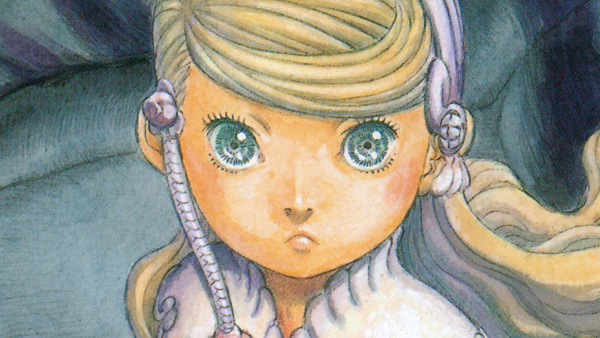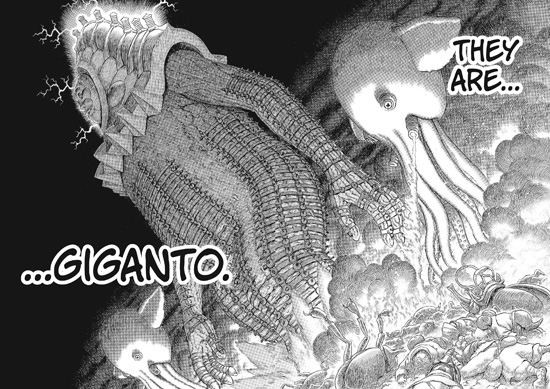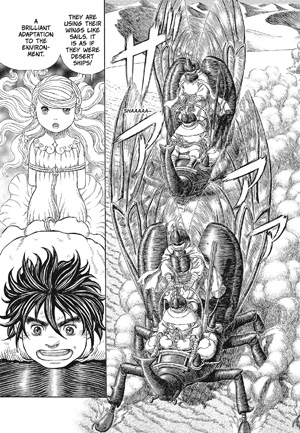 © KENTAROU MIURA 2014. All rights reserved. First published in Japan in 2014 by HAKUSENSHA, INC., Tokyo. English language translation rights in USA arranged with HAKUSENSHA, INC., Tokyo through TOHAN CORPORATION, Tokyo.
© KENTAROU MIURA 2014. All rights reserved. First published in Japan in 2014 by HAKUSENSHA, INC., Tokyo. English language translation rights in USA arranged with HAKUSENSHA, INC., Tokyo through TOHAN CORPORATION, Tokyo.In the past or post-apocalyptic future, a world of swords and sandals, Giganto—giant monsters—are the ultimate weapons of war. Delos, a beefy ex-slave with a boyish face, wanders the wasteland with his companion Prome, a strange little girl who rides around on his shoulders and bosses him around in computer-speak (“You are reckless, Delos. Accumulating more damage will exceed your vital functions!”).
When they meet a mutant desert tribe that lives symbiotically with giant beetles, Delos and Prome becomes involved in their struggle with an expansionistic, slave-trading human empire. But Delos is no ordinary warrior. For one thing, he’s a wrestler who fights without weapons and always subdues his opponents using his bare hands. For another thing, he has a special power … with Prome’s special powers, Delos can transform into Gohra, a 150-foot-tall Giganto who defeats other giant monsters with suplexes and piledrivers! Against fire-breathing octopus-elephants and imperial golems, Delos fights epic battles across a devastated planet in the name of peace!
 © KENTAROU MIURA 2014. All rights reserved. First published in Japan in 2014 by HAKUSENSHA, INC., Tokyo. English language translation rights in USA arranged with HAKUSENSHA, INC., Tokyo through TOHAN CORPORATION, Tokyo.
© KENTAROU MIURA 2014. All rights reserved. First published in Japan in 2014 by HAKUSENSHA, INC., Tokyo. English language translation rights in USA arranged with HAKUSENSHA, INC., Tokyo through TOHAN CORPORATION, Tokyo.Give Kentaro Miura (Berserk) an excuse to draw monsters and fight scenes, throw in weird masks and armor and weapons—all drawn in his ornately detailed style—and you know how good Giganto Maxia can be. Drawn apparently as a one-shot in between volumes of his 20-years-and-running epic fantasy Berserk, it’s hard not to look at its theme of humans who turn into giant warriors and think of recent megahit Attack on Titan. The series draws also heavily from Greek mythology—Giganto Machia, the legendary “war of the giants”—and another likely influence is Nausicäa,  with its postapocalyptic science-fantasy and big bugs.
with its postapocalyptic science-fantasy and big bugs.
The gentle, idealistic Delos is as different a heroine as can be imagined from Berserk’s ruthless swordsman Guts, and despite plenty of violence, Giganto Maxia has a hopeful mood: the morality strives for compassionate black & white, not grimdark gray. OTOH, the series more than earns its Adults Only sticker with the relationship between Delos and Prome, his bossy not-quite-human “contractor” who doesn’t wear panties and secretes, uh, “nectar” on the blushing wrestler to heal his wounds. (Given the lack of lolicon perviness in Berserk, are Miura’s tastes changing with age, or does he just do it for the fans?) For what it’s worth, this is implied more than shown, so that even those who find golden showers a red flag might be able to dig the other 180 pages of the manga, or just gape in awe at the art. It’s a shame that, at the moment, it’s only one volume. Recommended.
publisher: DMP/emanga.com
story and art: Kentaro Miura
rating: 18+


![Yokohama Station SF [Manga Review] Yokohama Station SF [Manga Review]](https://otakuusamagazine.com/wp-content/uploads/2023/11/Yokohama-Station-SF-v2-crop2-480x360.jpg)
![Manner of Death [Review] Manner of Death [Review]](https://otakuusamagazine.com/wp-content/uploads/2023/10/manner-of-death-v2-crop-480x360.jpg)
![Origin [Review] Origin [Review]](https://otakuusamagazine.com/wp-content/uploads/2023/10/origin-10-crop-480x360.jpg)
![Lady Oscar: The Rose of Versailles [Anime Review] Lady Oscar: The Rose of Versailles [Anime Review]](https://otakuusamagazine.com/wp-content/uploads/2021/11/RoV_Vol2_Front_CoverArt_V1-480x360.jpg)
![Kirby Manga Mania [Manga Review] Kirby Manga Mania [Manga Review]](https://otakuusamagazine.com/wp-content/uploads/2021/07/kirby-manga-mania-v1-16-9-480x360.jpg)
![Sunday Without God [Anime Review] Sunday Without God [Anime Review]](https://otakuusamagazine.com/wp-content/uploads/2021/05/sunday-without-god-1-480x360.jpg)